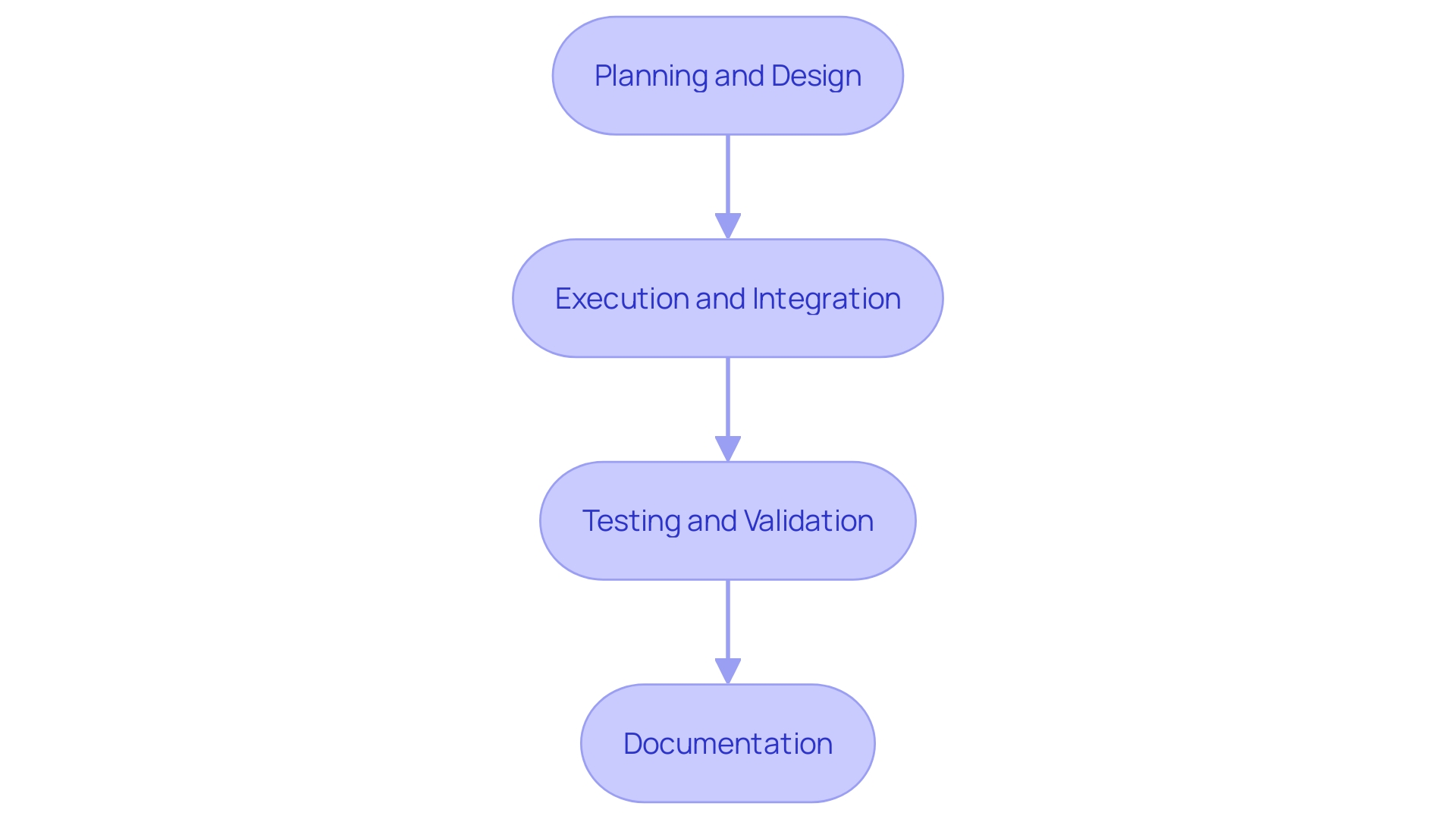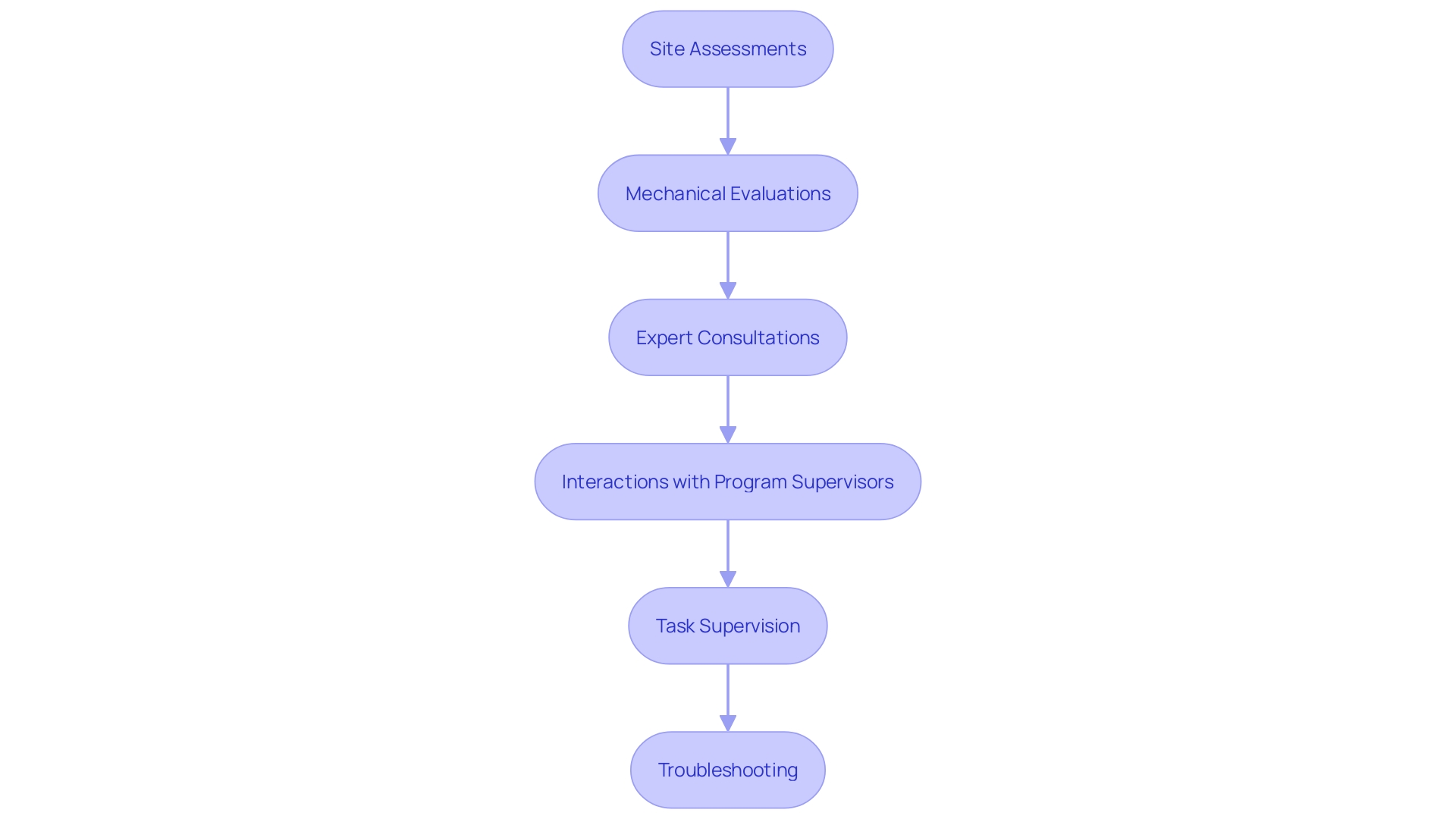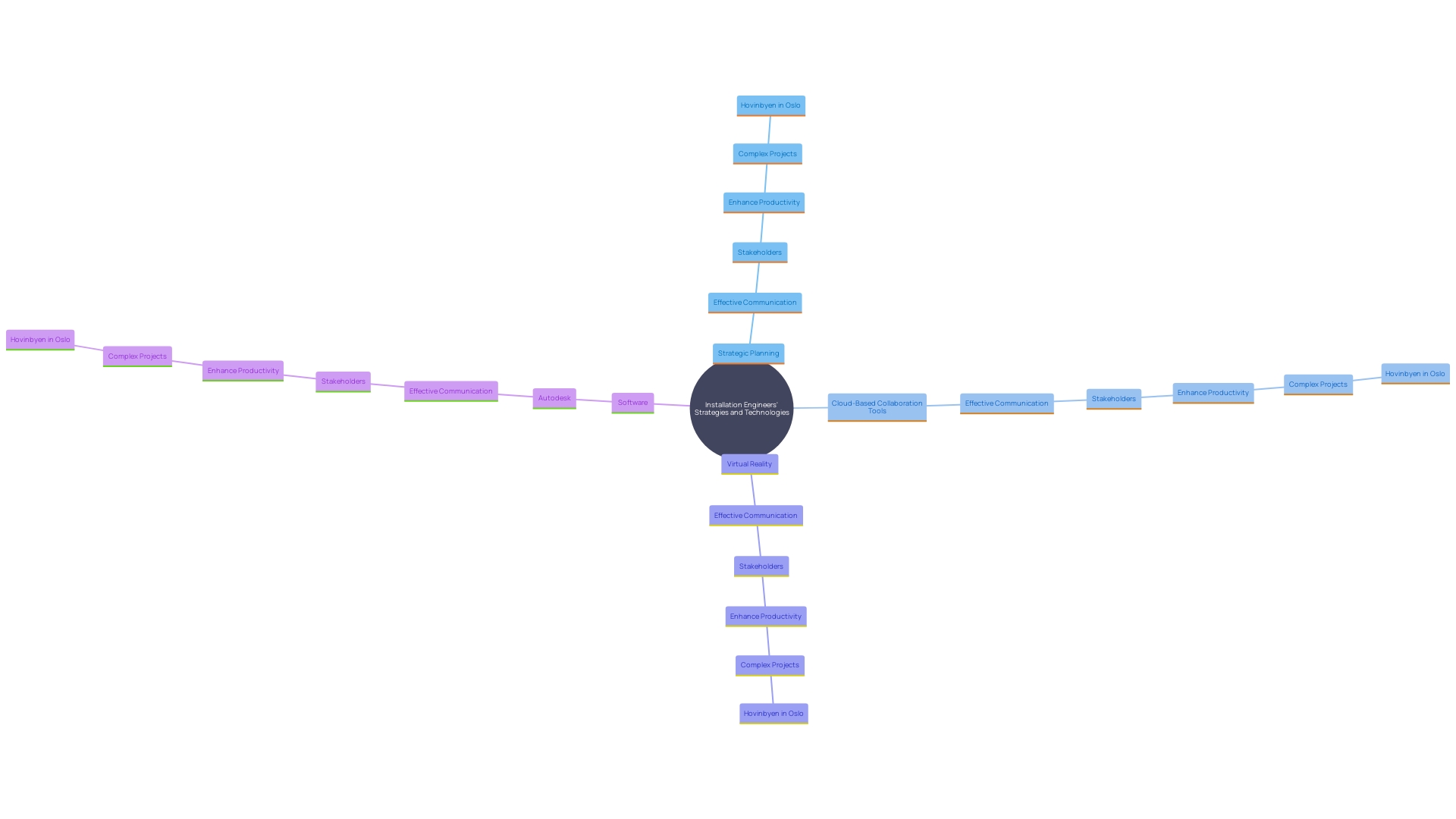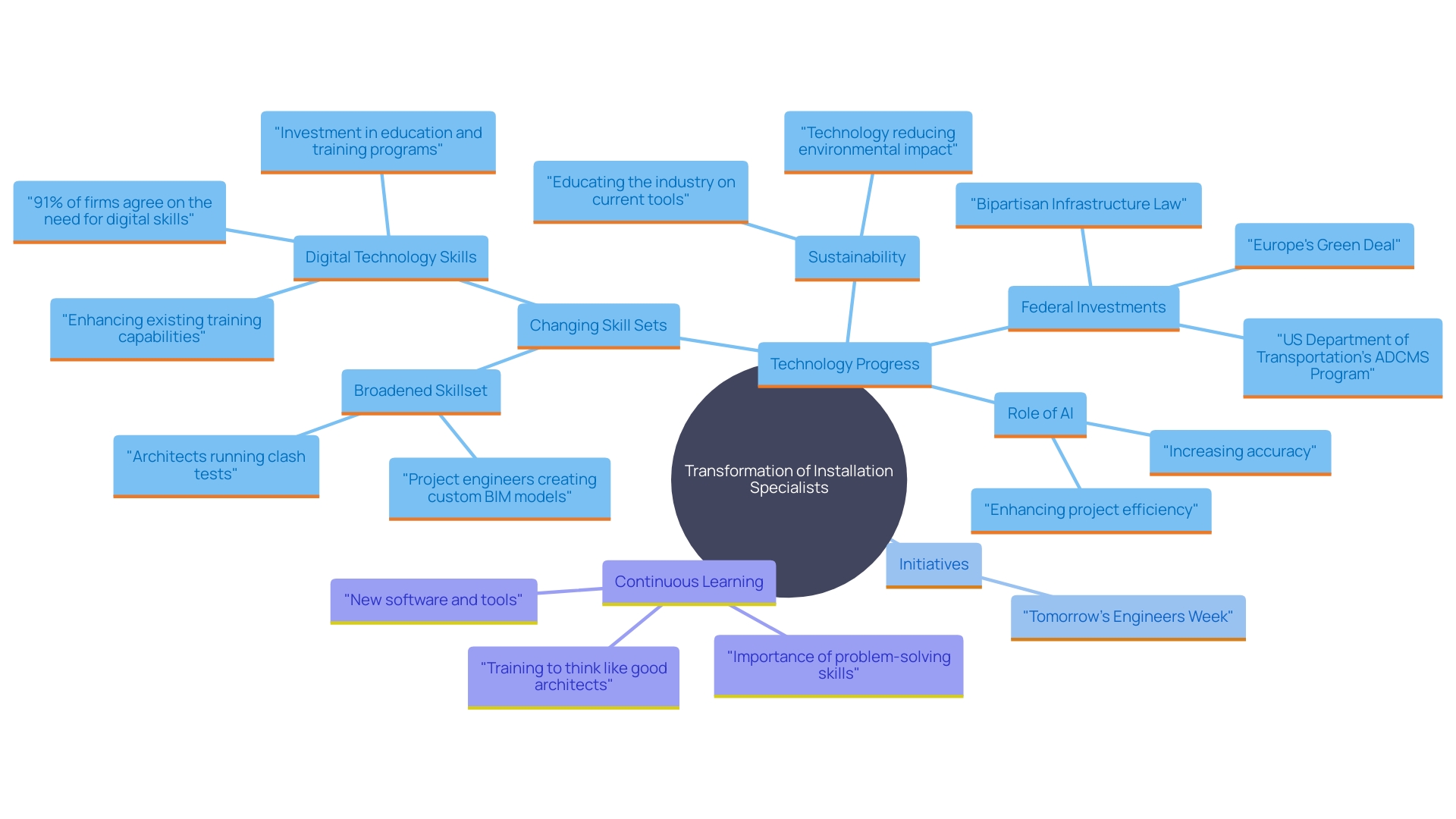Introduction
In the ever-evolving landscape of infrastructure development, the role of installation engineers is paramount. This article delves into the intricacies of installation engineering, highlighting its critical importance in ensuring seamless integration and operational efficiency of infrastructure projects. By exploring the key responsibilities and challenges faced by installation engineers, the discussion underscores their vital contribution to project success.
Additionally, practical solutions and innovative technologies that enhance the efficiency and effectiveness of installation processes are examined, providing valuable insights for overcoming common hurdles. With a forward-looking perspective, the article also addresses the future of installation engineering, emphasizing the need for continual adaptation and the adoption of advanced technologies to stay ahead in the industry.
Definition of Installation Engineering
‘Installation engineering involves the careful planning, design, and execution of setup processes for various construction undertakings.’. This discipline is crucial in ensuring that systems and components are seamlessly integrated, adhering to stringent technical specifications and industry standards. For example, in the Troll B Flowline Replacement initiative, the incorporation of new facilities is anticipated to enhance output by as much as 55 billion standard cubic meters of gas, illustrating the substantial effect of proficient engineering practices. Furthermore, rigorous testing and validation are essential, as highlighted by the need to validate models against real-world data to ensure practical applicability and to address inherent challenges. This role also involves comprehensive documentation and knowledge dissemination, providing valuable insights for both industry and academic advancements. By upholding elevated criteria and working together with specialists, engineering not only enhances technological abilities but also guarantees the operational effectiveness and safety of construction endeavors.

Key Responsibilities of Installation Engineers
Installation specialists play an essential role in the smooth incorporation of equipment and systems within infrastructure undertakings. Their responsibilities extend beyond site assessments and safety compliance. They are tasked with conducting detailed evaluations of mechanical equipment, ensuring all components are correctly adjusted, tested, and maintained. They also provide expert consultation and advice, helping to translate complex technical information into actionable insights for management. Successful interaction and collaboration with program supervisors are crucial, as assembly technicians arrange and supervise multiple tasks, making certain that the initiatives remain on schedule and within financial limits. Troubleshooting is another essential element of their job, as they promptly identify and address any issues that occur during the installation process, maintaining the integrity and safety of the work.

Importance of Installation Engineers in Infrastructure Projects
Installation engineers are essential to development initiatives, ensuring smooth execution and significantly minimizing delays and expenses. Their expertise not only facilitates the seamless integration of various systems but also enhances the overall quality and reliability of the framework. By ensuring that all systems operate as intended, they help reduce common issues such as high unit costs and extended delivery timelines, which are prevalent in many infrastructure endeavors.
Furthermore, thorough safety management practices, as emphasized in various case studies, highlight the significance of safeguarding workers and enhancing efficiency. Effective safety protocols not only safeguard workers from hazards like heavy machinery and falls but also help avoid costly delays and accidents. This is particularly crucial in road construction, where the accident rates are notably high. Furthermore, the collective and inventive methods arising in the sector, as observed in recent developments and the Infrastructure Investment and Jobs Act, indicate an increasing openness to transformation and a shift towards more comprehensive management practices.
By addressing gaps and continuously enhancing safety and efficiency standards, installation professionals play a crucial role in the successful execution of infrastructure initiatives. Their contributions are crucial in navigating the complexities of modern delivery systems, ensuring that endeavors are completed on time, within budget, and to the highest standards of quality and safety.
Challenges and Solutions in Installation Engineering
Installation engineers often navigate tight deadlines, complex requirements, and the critical need for effective communication among various stakeholders. To tackle these challenges, they utilize strategic planning, leverage advanced management tools, and encourage collaboration among team members to ensure successful delivery. For instance, in the massive Hovinbyen endeavor in Oslo, Norway, cloud-based design and collaboration tools have been pivotal in balancing diverse interests among multiple landlords, contractors, and clients. This technology facilitates a shared vision and clear communication, underscoring the importance of cooperation from the outset. Additionally, companies like Rivian have demonstrated how cutting-edge tools like virtual reality and Autodesk software can expedite design processes and reduce costs, emissions, and waste. Revizto has also been crucial in enhancing communication and teamwork, as noted by Sam Revel of Pitt Meadows, who stressed its importance in addressing constructability and design challenges effortlessly across various endeavors. These examples demonstrate how technology and strategic planning can greatly improve the productivity and effectiveness of technicians in overseeing intricate tasks.

The Future of Installation Engineering in Infrastructure Development
As technology progresses, the role of installation specialists is experiencing a significant change. The incorporation of intelligent technologies and automation in development initiatives requires a change in their skill sets and knowledge base. For instance, the implementation of intelligent systems at Tianjin Port has reduced the need for manual labor by 60%, highlighting the importance of adopting new technologies. This shift not only improves efficiency but also enhances safety, as remote operation of trucks mitigates hazardous working conditions for drivers.
The use of AI in infrastructure initiatives, like those carried out with the Pennsylvania Department of Transportation, highlights the capability of machines to carry out tasks typically managed by professionals, thus speeding up project completion and enhancing accuracy. Ai’s capacity to examine extensive datasets and deliver practical insights can transform how professionals tackle intricate problems, resulting in better-informed decision-making and creative solutions.
Moreover, industry-wide initiatives like Tomorrow’s Engineers Week inspire the next generation by showcasing diverse engineering careers and the exciting possibilities within the field. This week-long event aims to engage over 50,000 students, emphasizing the alignment of their skills and passions with the evolving demands of engineering roles.
In conclusion, embracing innovation and continuous learning will be essential for installation professionals to remain relevant and effective. Investing in education and training programs, as emphasized by industry experts, will ensure that current and future engineers are equipped to handle the technological advancements shaping the industry’s future.

Conclusion
The role of installation engineers is undeniably critical in the realm of infrastructure development. Their meticulous planning and execution ensure that systems are seamlessly integrated, adhering to strict technical specifications and industry standards. The impact of effective installation engineering is evident in projects like the Troll B Flowline Replacement, where enhanced infrastructure can significantly boost production.
Furthermore, rigorous testing and comprehensive documentation not only advance technological capabilities but also bolster operational efficiency and safety.
Installation engineers shoulder a diverse array of responsibilities, from conducting detailed mechanical evaluations to providing expert consultation and ensuring safety compliance. Their ability to communicate effectively with project managers ensures that timelines are met and budgets are adhered to, while their troubleshooting skills maintain project integrity. By addressing common challenges and implementing strategic solutions, installation engineers play a vital role in mitigating delays and reducing costs, ultimately enhancing project quality and reliability.
Looking ahead, the integration of advanced technologies and smart systems will continue to shape the role of installation engineers. The adoption of tools such as virtual reality and AI is revolutionizing project management, allowing for improved efficiency and safety. As the industry evolves, fostering a culture of continuous learning and innovation will be crucial for installation engineers.
By investing in education and embracing new technologies, they will be well-equipped to navigate the complexities of future infrastructure projects, ensuring their contributions remain indispensable to the success of the industry.

